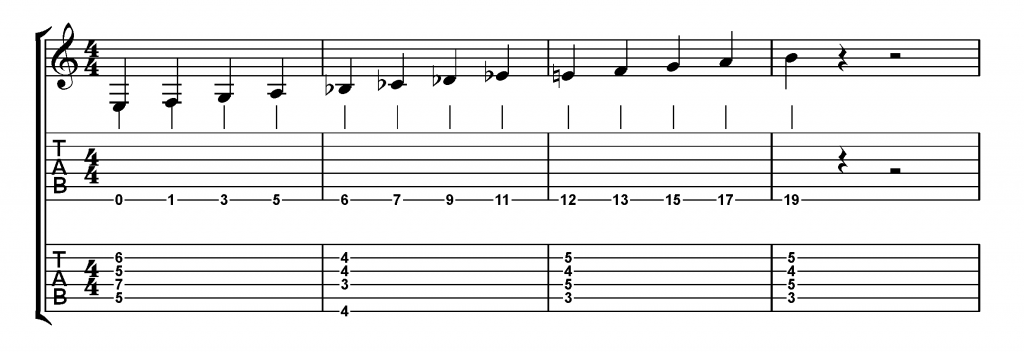Single String Soloing – By Pete Sklaroff
For many beginner guitarists, the first thing they ever play on the instrument is likely some kind of melody or run using single string soloing. In my case I’m pretty sure it was an attempt to play ‘Smoke On The Water’ by Deep Purple, which was a real effort at that time as I recall, despite it being a fairly simple riff. As we progress further on the instrument, we tend to become more focused on playing melodies and scales ‘in position’ as this is commonly taught as the standard fretboard approach by the majority of guitar teachers. Once positional playing has become reasonably fluent, most guitarists never return to single-string playing with any great seriousness, but in this article I’d like to point out some advantages in revisiting the ‘Single String Soloing’ approach
Many years ago I came across an excellent book by the renowned US jazz guitarist Mick Goodrick called the ‘The Advancing Guitarist’ and within the text, Goodrick emphasises just how useful single string soloing can be in getting a player to think differently about melody and interval playing and ultimately improvising. I found his ideas really refreshing and began to explore the concept in my own practice and playing.
The first application of this technique I examined was to take scales and arpeggios that I was already familiar with and transfer them onto to single strings. This was a little more difficult than I had imagined it might be when I first attempted it, but over time I grew more fluent and confident in applying the concept.

The example above is a simple C Major scale which has been transferred entirely to the A string beginning at the 3rd fret and then terminating at the octave on the 15th fret. Straightaway this made me think far more about the actual notes of the scale and where they were located along the string rather than just relying on a fretboard ‘shape’ to play the scale.
I further developed this exercise to then play the notes of the C Major scale along each and every string on the guitar, starting with the lowest available note and going up to the highest available note (depending on the number of frets available of course) See the example below for how this plays out on the fingerboard.

Once you have transferred all the notes of the major scale over to the low E string as illustrated in the above example, you then need to do the same thing with the remaining five strings. Once you have achieved this on all six strings, you can then try single string soloing on a single chord [or modal vamp] using these new single string scales. It will feel very different than playing in your regular scale positions, but I can just about guarantee that you will now sound quite different in your melodic approach and hopefully far more aware of what you are playing.
You can further develop this approach by using arpeggios too, as I’ve illustrated in the example below with a C major seventh chord played out along on a single string. You could also take the approach of playing from the lowest available note of the arpeggio on each string to the highest available pitch, which is shown on the second example below the first.


As before, take this arpeggio approach across all six strings to ensure that you are completely comfortable on any string using this technique. It may take a little while to
become fully fluent but it is worth the effort for the freedom it eventually affords you in playing like this, as you will not be as reliant on positional fingerings as you were before.
The whole approach of playing on single strings can of course be taken a great deal further than I am illustrating here – and just as an example of this I’m including a short passage below which shows the single string approach being employed when you have to change scales, rather than just use one a time. In this case, the chord progression is a II – V – I in the key of C, but with an ‘altered’ V7 chord, which forces me to use another scale type in bar 2 before returning to the C major scale in bars 3 and 4.

As you will hopefully have seen from the few exercises illustrated here, there are many ways that you can begin to employ single string playing in your overall approach to the guitar and in my view it can really expand your melodic vocabulary in a new and exciting way. Give it a go!
Have fun with it all,
Pete Sklaroff
Pete Sklaroff is the former Assistant Head of Music and Head of Jazz Studies at Leeds College of Music in West Yorkshire (where he taught for over 20 years) and he now works freelance as a professional guitarist, session musician, clinician and music educator/guitar tutor in the UK. His career spans over 25+ years as a professional musician and he has toured and recorded extensively in that time.
Pete is a highly respected and much sought after guitar teacher and has taught literally hundreds of musicians over the years both privately and within the Higher Education sector in the UK. His own studies have included lessons with the world famous jazz pedagogue Charlie Banacos amongst others.
Pete teaches all around the world via skype. If you’re interested in guitar lessons from a true UK Master, Check out his website here: www.online-guitar-lessons.org
“The artists you work with, and the quality of your work speaks for itself.”
Tommy Emmanuel
© Copyright Fundamental Changes Ltd 2025
No.6 The Pound, Ampney Crucis, England, GL7 5SA
